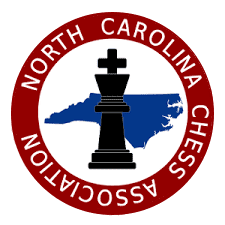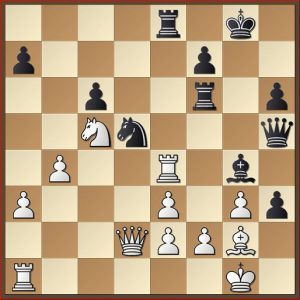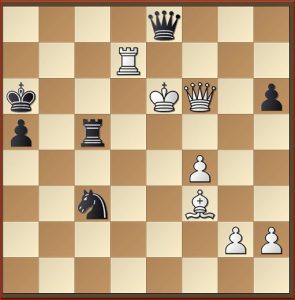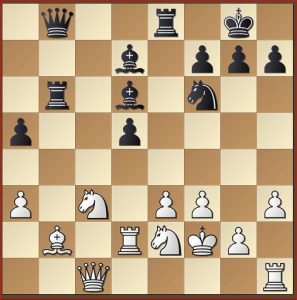 North Carolina Chess Association
North Carolina Chess Association
NCCA officers
Charles Roberson – President
John Timmel – First Vice President
Grant Oen – Scholastic Vice President
Wayne H. Spon – Secretary/Treasurer
North Carolina Gambit – August 2022
This month’s Contributors
Charles Roberson – Editor
Walter High
Aaron Wilson
John Timmel
Web support, edit, and distribution
John Timmel
In this issue, you will find:
Charles Roberson – Interview with Asha Kumar
Walter High – NC well-represented in National Tournaments
Aaron Wilson – Summer Heat – Lessons from Norm Chasing
Charles Roberson – Elo Rating System: The Myth of Playing Up
John Timmel – To Move and Win!
We’re looking for contributors to the Gambit!
Submit your games, articles, etc. to the editor Charles Roberson at croberson2@triad.rr.com
____________________________________________________________________________
NC Chess Interview
Interview with Asha Kumar and her parents by Charles Roberson
Asha Kumar is a NC chess player in the tenth grade. This year she won the NC Girls Scholastic Chess Championships making her NC’s invitee to the National Haring Invitational.
Asha performed well finishing tied for 2nd. She tied for first in the 2022 All Girls National Championship (U16). NC Chess interviewed Asha and her parents for this month’s newsletter.
My parents are supportive of me and my sister playing in chess tournaments. Although tournaments can be a stressful environment, they are also really enjoyable for the whole family.
My parents and I have always enjoyed going to the US Open every year.
My favorite tournament is NC states. Not only is states an amazing opportunity to improve your chess, it is also a place to meet other members of the chess community.
It is really exciting winning girls states. I’ve been playing in this tournament for the past four years, and it feels really great to finally win
I’ve been playing chess seriously and attending this tournament for four years.
As always, chess is full of uncertainties so I was unsure I would achieve it. All I could do was stay concentrated, and it ended up working out.
I usually celebrate a victory by going out to dinner with my family. Chess tournaments are often long and stressful so I think it is really important to reward yourself for the hard work.
I think when you treat a loss as a learning experience it becomes much more bearable. For example, it is beneficial to prioritize learning and growth over things like rating.
I have won the U-16 section in the girls national championship.
I got into chess after attending a summer camp at Durham Academy taught by Craig Jones.
I have been playing chess for about 6 years.
I was 9 years old when I started playing chess. |
The longest break I’ve taken from chess was for 6 months about a year ago. I started getting serious around the age of 12.
My first chess rating was 635.
My peak chess rating is my current rating, which is 1948.
My favorite thing about Chess is the community. I have met so many incredible people through chess.
I like that in chess, each player has a unique style. While it is a very analytical game, there is still lots of room for creativity.
I like being able to learn and be around great players in chess tournaments. There is so much to learn from others, and chess tournaments are a great place to do that.
While I enjoy competing in chess, ultimately it is an activity that I play to enjoy. As I move through high school and the future, I intend to continue playing chess at least recreationally as it is a huge part of my life.
Chess is so much less stressful when you don’t worry about rating.
My favorite player is Rameshbabu Praggnanandhaa.
I would like to meet Magnus Carlsen.
My favorite online chess site is lichess.com.
My favorite chess book author is Jacob Aagaard.
I would like to visit the Marshall chess club in New York City. |
_________________________________________________________________________________
NC well-represented in National Tournaments
by Walter High (wmhigh@nc.rr.com)
The United States Open is the biggest open annual chess event organized by US Chess. The most important aspect of this tournament is that the highest American finisher get an automatic bid to the 12-person Invitational USA Chess Championship the following year. North Carolina had two strong contenders to win this bid: GM Elshan Moradiabadi and GM Daniel Naroditsky. In a very exciting down-to-the-wire finish, GM Moradiabadi won the automatic bid by defeating GM Illia Nyzhnyk with black in the final round. GM Nyzhnyk was the highest-rated player in the tournament (US Chess rating: 2773). Moradiabadi scored 8.0/9.0 to finish in a two-way tie for first. The person he tied is not an American player, so Moradiabadi gained the automatic bid by default.
Ten North Carolina players made the long trip to Rancho Mirage, California to play this event. Unlike most large open chess events, the US Open only uses one pairing group, so in the 1st round, the differences in rating between opponents are often 700-900 points. Here are the final results for those 10 (out of 403 total entrants):
| Score | Place | |
|---|---|---|
| GM Elshan Moradiabadi | 8.0/9.0 | 2-way tie first 1st place |
| GM Daniel Naroditsky | 7.0/9.0 | 10-way tie for 5th place |
| NM Naveen Prabhu | 6.5/9.0 | 17-way tie for 15th place |
| Grant Oen | 6.0/9.0 | 29-way tie for 32nd place |
| Ritvik Maridi | 5.5/9.0 | 43-way tie for 61st place |
| Sam Indermaur | 5.0/9.0 | 53-way tie for 104th place |
| Sara Walsh | 5.0/9.0 | 53-way tie for 104th place |
| Arav Goldstein | 3.5/9.0 | 54-way tie for 263rd place |
| Krishna Rallabandi | 3.5/9.0 | 54-way tie for 253rd place |
| Virginia Oen | 3.0/9.0 | 30-way tie for 317th place |
The United States Open Chess Tournament is supplemented by a host of special event tournaments where representation is by individual State Champions. The oldest of these supplemental tournaments is the Denker, which brings together the 50 state high school champions (K-12). More recent creations: the Barber (K-8), the Rockefeller (K-5), the Haring (K-12 girls), and the Irwin (Senior: 50+ years of age). These tournaments concluded on August 2nd and North Carolina was well-represented in each one.
Here are the results for our NC players:
| Event | Score | Place | |
|---|---|---|---|
| Denker (K-12) | Naveen Prabhu | 4.0/6.0 | 11-way tie for 6th place |
| Barber (K-8) | Jerry Xue | 4.0/6.0 | 5-way tie for 9th place |
| Rockefeller (K-5) | Krishna Rallabandi | 4.0/6.0 | 5-way tie for 8th place |
| Haring (K-12 girls) | Asha Kumar | 5.0/6.0 | 2-way tie for 2nd place |
| Irwin (Senior 50+) | Mark Hoshor | 3.0/6.0 | 10-way tie for 17th place |
These are outstanding results for North Carolina! In a six-round tournament, every NC representative scored at least 3.0 (no negative scores). Asha Kumar came within a whisker of winning her tournament! If you see any of these players at your next couple of tournaments, take a minute to congratulate them on their performances.
The North Carolina Chess Association is responsible for determining these representatives through Championship events each year. The Association also provides financial support to ensure that the State is represented because going to the United States Open venue is often an expensive endeavor. This year the tournaments were being held at a resort in Rancho Mirage, California (near Palm Springs). Your annual dues help send our representatives to these events. North Carolina is in the forefront of state organizations in assisting our representatives to attend.
I could not be more pleased at how well North Carolina is represented by its chess players on the national level. There are a number of people who are working diligently to raise the level of chess in North Carolina and the results are quite evident. Please support your local chess clubs and do your best to attend the major events within the State. The progress we have made is astounding.
_________________________________________________________________________________
Summer Heat – Lessons from Norm Chasing
Aaron Wilson
The summer is heating up and with it – norm chasing is heating up at the Charlotte Chess Center and Scholastic Academy as players compete in the Summer IM/GM Norm Invitational. With 40 players looking to gain titles and fight in some exciting games, this tournament is one of the most exciting of the summer in the NC chess scene. I hope to feature some quick lessons from these games so that you can take something away from it!
The tournament features some very prominent names in the chess world who I am sure readers will recognize:
- FM James Canty – who has a great YouTube Channel: https://www.youtube.com/c/JamesCantyIII
- IM Dean Ippolito
- Young FM Tani Adewumi – who many will know from ChessLife articles and winning the 2019 K-3 New York State Chess Championships
- IM Kassa Korley
- FM Gauri Shankar
- Our own home-grown IM Tianqi Wang!
- And the well-known author GM Jacob Aagard – who needs no introduction
Let’s start off with newly minted IM Tianqi Wang’s battle against FM Doug Eckert. The game featured a Ruy Lopez but with an early exchange on c6 (full game at this link: https://lichess.org/study/2PQRXg4P/9DqjMI36).
After 5. …Qf6, how did IM Tianqi Wang open the center and fight for the initiative?
After 10. …Be6, the natural developing move Nc3 is an obvious candidate move, but what did IM Tianqi Wang do to continue his slight initiative?
In this position, after 16. …Bg7, White has a slight edge, how did IM Tianqi Wang re-route his Knight to take advantage of potential outposts?
After the move 28. …Rd8? how did IM Tianqi Wang convert into a winning endgame with a powerful Knight on an outpost?
One move 49, Black played …Nf6, how can White mate in three from this position?
_________________________________________________________________________________
Elo Rating System
The Myth of Playing Up by Charles Roberson
This month I will discuss the Elo rating system, some history, the fundamentals of how it works and the myth of playing up.
Arpad Elo invented the system which was adopted by the USCF in 1960 and it was adopted by FIDE 10 years later in 1970. He used real tournament data from the USCF to develop his system. This would have been quite the effort considering that the hand held calculator hadn’t been invented and he was possibly limited to pencil, paper and a slide rule. It is still in use by the USCF and has been modified on several occasions. One includes a big change in 2015 which deals with the rapid rating increase of new people relative to established players which caused established players to lose lots of points thus deflating the upper middle group of the players.
The mathematical system is based on expectation. If you perform to expectation, your rating doesn’t change. Perform above or below expectation and your rating will increase or drop accordingly. The system doesn’t allow you to increase your rating just by competing in more tournaments than anybody else. You must perform above expectation to increase your rating. So what is expectation and how is it calculated? How can the rating system know how you should perform?
The system expects you to perform exactly to your rating. It expects people rated higher than you to perform higher than you and the opposite for people rated lower. If you play a group of people with an average rating equal to yours the system expects you to turn in a 50% performance. If you play 5 opponents with an average rating of 1500 and you are rated 1500 the system expects you to score 2.5 out of 5. If you score 3 or more out of 5 tournament points then your rating will go up. Score 2 or less points out of 5 and your rating drops. The further away from expectation you perform, the more your rating will change. Also, your rating will change more in bigger tournaments than smaller ones. The base system will give you more points for performing above expectation in a 5 game tournament than in a 3 gamer. On top of that, there are bonus points for tournaments with 3 or more games and and more bonus points for the same level of performance for even bigger tournaments.
The system is based on a standard deviation of 400 points. A person rated 200 points higher than his/her average opponent is expected to win 76% of the tournament points. A person rated 500 points higher than his/her average opponent is expected to win 95% of the tournament points. Conversely, a person rated 200 points below his average opponent is expected to win 24% of the points and 5% of the points if he is 500 rating points below his average opponent. So, you can be one of the lower rated players in the field and raise your rating by scoring only 1 win out of 5 or get the same rating improvement by 2 draws out of 5. If you want all the mathematical details you may read this document
Rating System Algorithm.
Now for the myth of playing up. Many think that if you want to raise your rating as fast as possible you should play up a section and the rating system will boost you more. This is not true. If you perform 200 points above your rating, then your rating will go up a given amount no matter how you did it. Let’s say you are rated 1600. There are lots of ways to perform at the 1800 level. Just to identify a few:
- You play a field of 1400 rated players and win every game.
- You play a field of 1600 rated players and score 76% of the games.
- You play a field of 1800 rated players and score 50% of the games – in 5 games you get 5 draws or 2 wins and a draw.
- You play a field of 2000 rated players and score 24% of the games – in 8 games you score 4 draws or 2 wins or 1 win and 2 draws.
If you have used the USCF ratings estimator to get a quick estimate of your post tournament rating change ( at USCF rating estimator ), you’ll see that it doesn’t ask how you performed against each opponent; it asks each opponent’s rating and how many total tournament points you scored. So, it wants to know your average opponent, how many games and your overall score. It doesn’t care which opponent you won, drew or lost to. Lets look at some real numbers.
| Games | 2 | 2 | 2 | 3 | 3 | 4 | 4 | 4 | 5 | 5 |
|---|---|---|---|---|---|---|---|---|---|---|
| Rating | 1600 | 1600 | 1600 | 1600 | 1600 | 1600 | 1600 | 1600 | 1600 | 1600 |
| Performance | 1800 | 1791 | 1800 | 1800 | 1800 | 1800 | 1791 | 1800 | 1800 | 1800 |
| Opponents | 1400 | 1600 | 1800 | 1400 | 1800 | 1400 | 1600 | 1800 | 1400 | 1800 |
| Score | 2 | 1.5 | 1 | 3 | 1.5 | 4 | 3 | 2 | 5 | 2.5 |
| Bonus Points | 1.49 | 6.73 | 8.14 | 9.55 | 10.23 | 13.6 | ||||
| New Rating | 1620 | 1620 | 1621 | 1628 | 1631 | 1642 | 1645 | 1648 | 1652 | 1659 |
The above table came from entering data into the USCF rating estimator and we see multiple perfect scenarios for 2, 3, 4 and 5 game tournaments. I say perfect scenarios because I am assuming that you’ll play against exactly the correct opponent’s to achieve the intended rating gap, but more on this later. Before we get into the potential of playing up, lets observe a general trend that holds true: you get more points for performing at a given level by playing in tournaments that have more rounds if you play all the rounds. Notice, that a 1600 player performing at 1800 and playing an average field of 1400 gains 20 points in a 2 game tournament vs 52 points in a 5 game tournament against the same strength opponents.
We see that in 3 scenarios for 2 game tournaments playing up doesn’t make any real difference, all scenarios resulted in a new rating of 1620 except for the last scenario which resulted in 1621 (only 1 extra point). In a 3 game tournament, we see that playing up gains only 3 extra points. In a 4 game tournament, playing up yields an extra 6 points: a gain of 48 instead of 42. Finally, in a 5 game tournament, playing up yields an extra 7 points: a gain of 59 instead of 52. The extra yield is small and only if you can perform that well, if not playing up will not help.
So, there is nothing magical about playing up or any real advantage in the math: you have to perform well. The issue is that when you play higher rated players, you might not perform so well and thus lose rating points. In such cases, playing up is self defeating. Also, the probability of you scoring against each opponent is reduced, thus decreasing your odds of gaining rating points. To make things worse, you are making the tournament worse for those that have to play you: in effect, they are playing down when playing you. If you play too far up, you can hurt the integrity of the tournament. In such cases, everybody that plays effectively has a bye. If enough people play up, the tournament integrity can be sufficiently damaged.
On July 23, I ran a tournament in Burlington. There were two kids in the middle section that wanted to play up. I moved one of them up. The kid that didn’t play up won all of his games while the kid that played up score 1.5 of 3. The kid that didn’t play up gained 25 rating points and the other gained 11. So, the “magic” of playing up didn’t help. You might say that it gives you more experience playing stronger players which will help you learn faster. Well, what about the stronger player that had to play you the weaker player? Wasn’t that a diminished experience for him? Think of it this way: for each person playing up in a 5 game tournament, there are 5 people that have to play down for one of their games. This suggests there are more negatives than positives.
Additionally, playing up has some potential negatives for the person playing up. You will be the lowest rated player or one of the lowest rated players if several play up which can lead to several issues. All of these issues will partially defeat the purpose of playing up.
- If there is an odd number of people in your section and you are the lowest rated player, you will get a bye the first round.
- If multiple people play up and the section has an odd number of people, you will likely get a bye in one of the rounds if not the first.
- If multiple people play up and you perform similarly, you’ll end up playing each other in the late rounds.
- You could end up playing somebody else that played up and get a bye in a round.
Here are two of the tournament pairing rules that can cause these events. The first is the lowest rated player with the worst score in each round gets the bye. If you play up, you could be the lowest rated player. The second is that you pair people together that have the same score or nearly the same score in each round. After a few rounds, you may be paired with others that played up. So, there is zero guarantee that playing up will go the way you want nor is there any guarantee that you’ll get to play multiple much higher rated opponents.
For these reasons, there will be a new rule in the chess tournaments that I run: no playing up. You will be in the section that your rating puts you in.
_________________________________________________________________________________
To Move and Win!
By John Timmel
Last Month’s Spassky – Fischer

White to move and win:
38. Bc5!
The game continued
38.Bc5! a6 [38…b6? 39.Bxb6+– axb6 40.a5 bxa5 (40…Kd5 41.a6+–) 41.b6+– Byrne] 39.b6! f5 40.Kh4 … ¢g5–g6–c7 +– 40…f4? 41.exf4 Kxf4 42.Kh5! Kf5 43. Ke4 44.Bf2 Kf5 45.Bh4 e5 46..Bg5 e4 47.Be3 Kf6 48.Kg4 Ke5 49.Kg5 Kd5 50.Kf5 a5 51.Bf2 Zugzwang [51.Bd2? Kc5 52.Bxa5 e3= Timman] 51…g5 52.Kxg5 Kc4 53.Kf5 Kb4 54.Kxe4 Kxa4 55.Kd5 Kb5 56.Kd6 [56.Kd6 a4 57.Kc7 Ka6 58.Bc5 Kb5 59.Bf8 Ka6 60.Be7+–] 1–0
_________________________________________________
Nepomniachtchi, Ian

Ding Liren
Black to Move and win: 28……….hxg2!
The game continued
29.Rxe8+ Kg7 …white is lost, the threat is Rxf2
30.f4 Qh1+
31.Kf2 Qxa1
32.Kxg2 Bh3+
_________________________________________________
Radjabov, Teimour

Caruana, Fabio
White to move and win: Kd6
The game continued
49.Kd6 Rc4
50.Rc7 Kb5
51.Qe5+ Qxe5+
52.fxe5 Rxc7
53.Kxc7 Kc5
54.e6 Nb5+
55.Kd7 a4
_________________________________________________
Radjabov, Teimour

Ding Liren
Black to move and win: Rxe3!
_________________________________________________